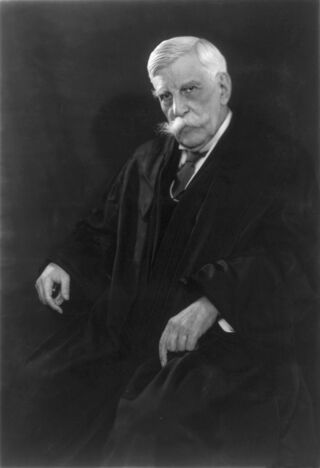Law and Crime
The Supreme Court's Buck vs. Bell Decision Was Not Unanimous
A Catholic Justice cast the sole vote against eugenic sterilization.
Posted September 28, 2020 Reviewed by Lybi Ma
The Buck vs. Bell (1927) case is one of the most notorious Supreme Court decisions in U.S. history. In an 8-1 decision, the Court upheld the Virginia Sterilization Act of 1924, saying that American citizens could be subject to involuntary sterilization "for the protection and health of the state." As a direct consequence of this decision, Carrie Buck, a young mother alleged to be "feeble-minded" and "promiscuous," had her Fallopian tubes removed by the state. In the majority opinion, Associate Justice Oliver Wendell Holmes, Jr. wrote:
We have seen more than once that the public welfare may call upon the best citizens for their lives. It would be strange if it could not call upon those who already sap the strength of the State for these lesser sacrifices, often not felt to be such by those concerned, to prevent our being swamped with incompetence. It is better for all the world, if instead of waiting to execute degenerate offspring for crime, or to let them starve for their imbecility, society can prevent those who are manifestly unfit from continuing their kind. The principle that sustains compulsory vaccination is broad enough to cover cutting the Fallopian tubes.
According to Holmes, since the state can already draft citizens to fight and die in wars, and can also compel participation in mass vaccination programs, why shouldn't the state also be able to compel the "lesser sacrifice" of being surgically sterilized? After all, he seems to say, the only people so affected would be those whose progeny would grow up to become criminals or beggars. There are few more brazen examples of "eugenic" thinking in American jurisprudence. Holmes's chilling conclusion to his opinion referenced Carrie Buck, her mother, and her infant daughter: "Three generations of imbeciles are enough."

While Holmes is usually reviled, appropriately enough, for this decision, it should be noted that he only wrote the majority opinion — seven other justices voted with him. Among them were Chief Justice William Howard Taft, previously the 28th President of the United States. Perhaps most surprising was the assent of Associate Justice Louis Brandeis, the first Jewish person ever to serve on the Court, and, in the words of William O. Douglas, "a militant crusader for social justice."
The sole dissenting vote in Buck vs. Bell was Associate Justice Pierce Butler, who served on the Court from 1922 until his death in 1939. Butler's parents were immigrants from County Wicklow, Ireland, who fled the Great Famine and settled in Minnesota. Butler and his eight siblings were born in a log cabin. They were raised within the Roman Catholic Church and Butler remained a devout practitioner of the Catholic faith throughout his life.
As a lawyer, he quickly won the respect and admiration of his peers. He was elected to serve as his county's attorney, and then as president of the Minnesota State Bar Association. Like Abraham Lincoln, he earned quite a bit of money defending the interests of railroad corporations and their shareholders. He was nominated to serve on the U.S. Supreme Court by President Warren G. Harding, despite that Harding was a Republican from Ohio and Butler was a Democrat from Minnesota.
The nomination of Pierce Butler was strenuously opposed, and by a curious mix of adversaries. These included labor unions, liberal magazines such as The New Republic and The Nation, and even the head of the Progressive Party, Senator Robert M. La Follette of Wisconsin. The Ku Klux Klan was the only group to state openly that they opposed Butler because he was a Roman Catholic. Nevertheless, he was confirmed by the Senate in a 61-8 vote and took his seat on the Court in 1923.

In 1925, Butler sided with the Court's unanimous decision in Pierce vs. Society of Sisters, which overturned an Oregon state law that said parents could not send their children to religious or other private schools. In 1928, he wrote one of four dissenting opinions in Olmstead vs. the United States, arguing for a broad interpretation of the Fourth Amendment's protection against unwarranted search and seizure by the state. He thought that Olmstead, a bootlegger who was convicted on the basis of wiretapping, should receive a retrial. Butler's judicial philosophy was that the Constitution served to protect individuals from the ever-expanding powers of the state. His solo dissent in Buck vs. Bell (1927) is certainly consistent with this view.
Associate Justice Holmes, during the deliberations prior to issuing the Buck vs. Bell decision, remarked that "Butler knows this is good law. I wonder if he will have the courage to vote with us in spite of his religion." It is interesting that Holmes seemed to believe that the only reason Butler might be opposed to upholding the Virginia Sterilization Act would be because the Roman Catholic Church opposes sterilization, and not because he was wary of handing such powers to the state. Unfortunately, during this era of the Supreme Court, it was relatively common for dissenting votes not to be accompanied by a written dissent; we cannot know the specifics of Butler's reasoning in this case.
Butler was the lone dissenter in another case — Palko vs. Connecticut (1937). Palko shot and killed two police officers while trying to avoid apprehension for a robbery. He was tried by the state of Connecticut on the charge of first-degree murder, but the jury convicted him only of second-degree murder. The state then retried him and obtained the first-degree murder conviction that they had wanted all along. Butler was the only Justice who believed that the state should not have the unrestrained freedom to try a person for the same crime twice. The 8-1 decision led to Palko's execution in the electric chair.
In both Buck vs. Bell and Palko vs. Connecticut, it might appear to some that it was the religious beliefs of Associate Justice Pierce Butler that guided his decisions. After all, the was Roman Catholic and the Roman Catholic Church is adamantly opposed to both involuntary sterilization and to the death penalty. However, it appears more likely that the source of his solo dissents in both of these cases was his overall judicial philosophy — that for liberty to survive, the powers of the state must be kept in check.




